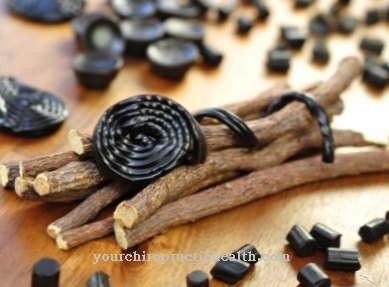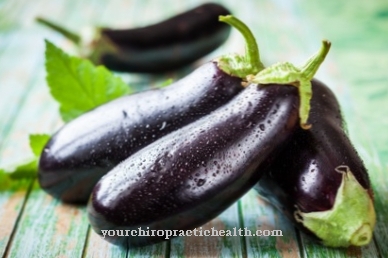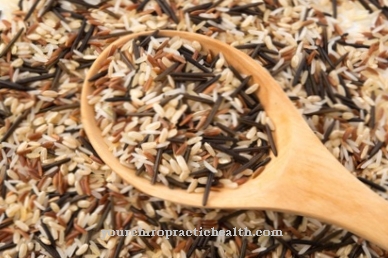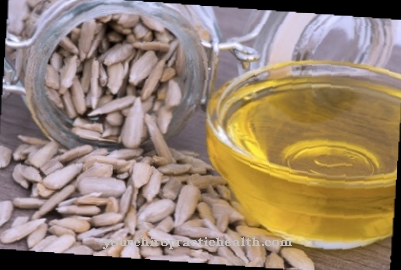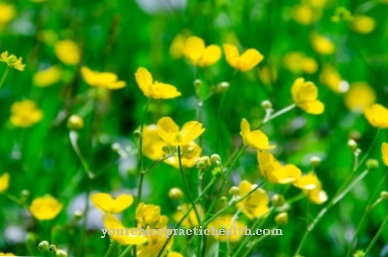The Ice herb is an edible plant in the midday flower family. The herb, which comes from Africa, can also be grown in Europe and is usually prepared in the form of salads. However, it can also be used as a medicinal herb to fight fever or to care for the skin.
What you should know about ice herb

Iced herb has the Latin name Mesembryanthemum crystallinum. The eye-catching plant owes its common name "ice herb" to the surface design of its leaves and stems. Because the lush green parts of the herbaceous plant actually appear to the observer as if they were covered with thousands of tiny ice crystals.
This appearance is due to the build-up of salt deposits on the surface of the leaves and stems of the ice herb as moisture evaporates. The edible plant, which is rather little known in Europe, is also sold under the names Kristallkraut or Eisblume and originally comes from South Africa. Today, however, it can also be found throughout the Mediterranean and can even be grown as an annual plant in more northern regions.
The fact that it also thrives in temperate latitudes is thanks to a genetic advantage: In contrast to most other plants, which on average have two sets of chromosomes, the ice herb has over 120 sets of chromosomes. This means that the ice herb, which is classified as a creeping plant, can adapt to a wide variety of circumstances.
Since it is very resistant thanks to its resilience and adaptability, it is also known as the "plant of life". However, ice herb is very demanding to cultivate and requires a loamy-sandy soil that is as rich in nutrients as possible and a sunny location. In optimal conditions, it has a very long harvest period, which extends from April to September. In order to preserve the valuable ingredients, it should be harvested as soon as possible before consumption. To do this, the leaves of the ice herb are cut off with a sharp knife - the plant itself remains in the ground. It forms fresh shoots again shortly after harvesting. In terms of taste, the iced herb appeals to lovers of hearty salads and vegetables. It tastes slightly salty to sour - and its taste is a bit reminiscent of spinach.
Importance to health
Iced herb contributes to a health-conscious diet because it contains many valuable ingredients. Salads or vegetable side dishes with ice herb are particularly recommended for people who pay attention to the acid-base balance of their body.
Iced herb is generally an enrichment for vegetarian or vegan cuisine. It is also popular as an accompaniment to fish or meat dishes. The versatile edible plant supplies the organism with important minerals and vitamins, among other things. The iced herb is particularly valuable when it is processed fresh. In addition to being used in food, ice herb can also be used in a health-promoting manner in other ways: For example, putting ice herb on is a home remedy for fever. To do this, the leaves of the plant should be crushed. They are then placed in places where the pulse is taken - for example on the inner wrist or neck.
A small bandage keeps the antipyretic natural remedy securely in place. The use of the ice herb in the form of extracts for skin care is also known from folk medicine. For this purpose, either an alcoholic extract or a tea is made from ice herb and rubbed on the skin. This can help against various skin diseases and can also be used for generally sensitive skin. Because of this effect, ice herb is used in numerous cosmetics today.
Ingredients & nutritional values
Ice herb is particularly characterized by a high proportion of mineral salts in its leaves. Magnesium and sodium salts in particular can be found in abundance in this crop. The concentration of these substances is higher, the more nutrient-rich the soil in which the ice herb is grown.
In addition to the minerals, it is also valued by connoisseurs for its proportion of high quality protein and fat and valuable vitamins. The nutritional value of the ice herb is roughly the same as that of New Zealand spinach. This has a calorific value of approx. 21 kcal per 100 g. The valuable ingredients come into their own when the iced herb is prepared as a salad or gently steamed.
Intolerances & allergies
There are generally no known allergic reactions to ice herb. However, since it is a natural product, they can never be ruled out. In general, however, ice herb is considered to be well tolerated - and even beneficial to health. For example, cream with ice herb extracts is used specifically to care for and soothe sensitive skin.
Shopping & kitchen tips
Since the ice herb is healthier, the fresher it is on the table, it should only be harvested shortly before preparation. Studies show that ice herb sown in spring should be harvested after about 10 to 13 weeks. Because then it is richest in vital substances.
In order to incorporate the valuable edible plant firmly into your own nutritional program, it is therefore advisable to grow the iced herb yourself. This can be done in a sunny garden bed or in a large pot on the balcony. Since the plant sprouts again immediately after the leaves have been cut, there is always fresh ice herb available throughout the summer. However, if you buy the leaves in stores, for example in a well-stocked organic market, you should use them as quickly as possible. For longer storage it is recommended to put the edible plant in the refrigerator. It can be stored there for some time - but not longer than four days.
In the kitchen, the iced herb is processed in the same way as all other types of salad: after thorough rinsing, it only has to be plucked and seasoned with a dressing or a vinaigrette to make it ready to eat. Iced herbs that are intended for cooking can also be stored frozen.
Preparation tips
Iced herb is preferred for the preparation of salads because it has firm, juicy leaves and stems. Its slightly salty and sour taste sets it apart from other types of salad. In combination with a lemon-based vinaigrette, for example, it is extremely tasty. Another tasty option is to combine an iced cabbage salad with onions to make a hearty dish.
In the French gastronomy, the plant has gained a firm place under the name "ficoide glaciale". It is preferably served as a side salad to fish dishes or creations with seafood. In addition to being used as a salad, the ice herb is also very suitable as a vegetable side dish. It is simply steamed briefly to preserve its valuable minerals and nutrients. In this form of preparation, ice herb is very similar to spinach - so it can be processed in a similar way.

